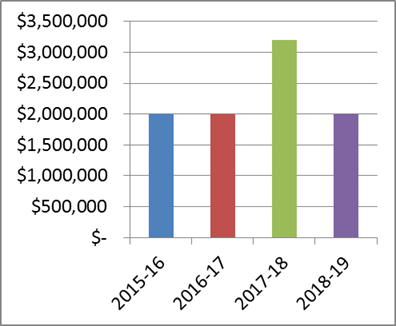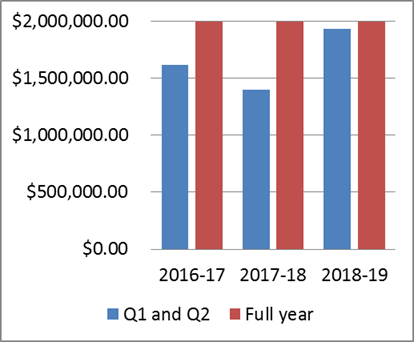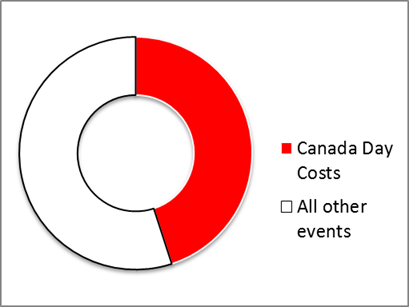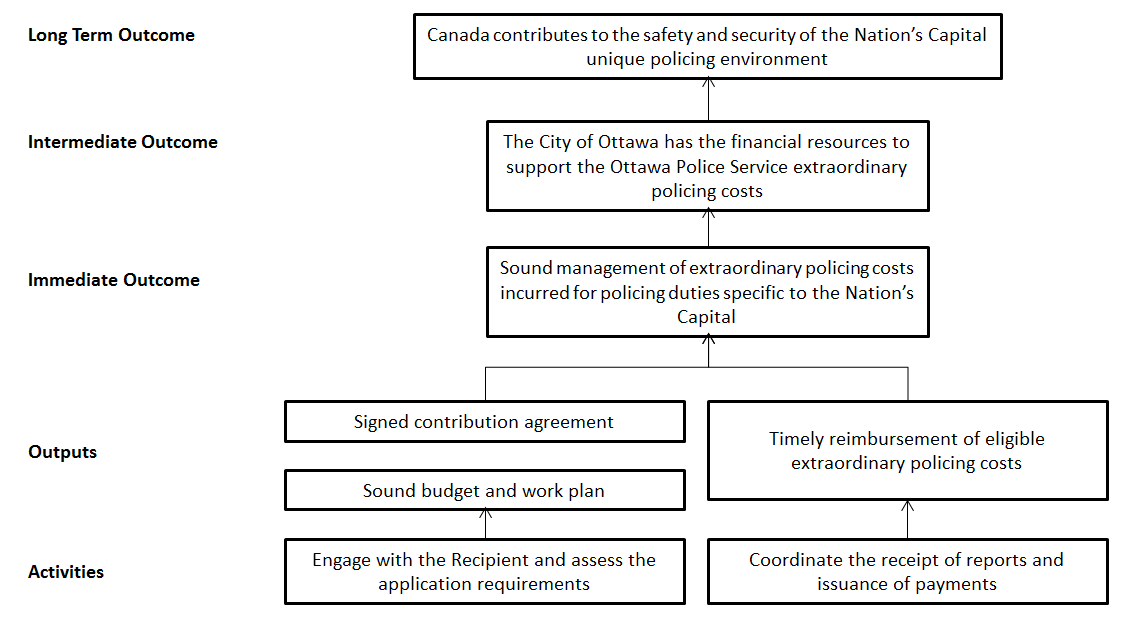Evaluation of the Nation’s Capital Extraordinary Policing Costs Program
 Evaluation of the Nation’s Capital Extraordinary Policing Costs Program PPT Version (962 KB) Evaluation of the Nation’s Capital Extraordinary Policing Costs Program PDF Version (899 KB)
Evaluation of the Nation’s Capital Extraordinary Policing Costs Program PPT Version (962 KB) Evaluation of the Nation’s Capital Extraordinary Policing Costs Program PDF Version (899 KB) July 2019
Executive Summary
This report presents the results of the Evaluation of the Nation’s Capital Extraordinary Policing Costs Program (NCEPCP).
What we examined
The purpose of the evaluation was to examine the relevance and performance of NCEPCP from its inception in 2015-16 to 2018-19.
What we found
There is a continued need for NCEPCP. OPS polices approximately 203 events every year and the cost for security is increasing. Other capital cities are funded for policing and security related to national capital events.
All program funding is used for extraordinary policing costs related to the Nation’s Capital with the majority of costs, over 75% since 2015-16, attributed to personnel.
The City of Ottawa would have difficulties addressing extraordinary policing costs without the ongoing support of NCEPCP. Canada Day has accounted for half of all program spending and the City of Ottawa absorbs additional related costs.
The Contribution Agreement was amended to add $1.2 M for fiscal year 2017-18 to support heightened security and policing requirements for Canada Day 150 events. Even with these additional funds, OPS expenditures exceeded the funding.
Funding provided by the program contributes to an increased sense of safety and security at events in the Nation’s Capital as it supports OPS’ ability to deploy adequate personnel.
It was noted that the City’s response to events, such as protests, can include fire, paramedic and transit services, in addition to police services.
There have been no concerns with duplication of funding efforts. Information provided by the Recipient does not appear to be used for anything beyond administrative purposes.
When planning for events, the primary considerations are crowd size and dynamics though there is a growing awareness of accessibility. To date, GBA+ has not played a role in the design and delivery of the program.
Recommendations
The Assistant Deputy Minister of the Community Safety and Countering Crime Branch should, as part of program renewal:
- Examine the full scope of security costs related to events unique to the Nation’s Capital and explore options to engage other federal partners in supporting these costs;
- Assess performance measurement and reporting requirements at both the program and recipient level;
- Include GBA+ considerations in program design and implementation.
Management Action Plan
Management accepts all recommendations and will implement an action plan.
Overview and Background
This report presents the results of the Evaluation of the Nation’s Capital Extraordinary Policing Costs Program (NCEPCP).
Following the terrorist attack at the War Memorial and Parliament Hill on October 22, 2014, the Economic Action Plan 2015 announced the Government of Canada would provide $10 million over five years to the City of Ottawa to support the extraordinary policing costs incurred by the Ottawa Police Service (OPS) in performing policing duties specific to the Nation’s Capital.
NCEPCP is a contribution program whose purpose is to reimburse the City of Ottawa in recognition of the unique policing environment created by the presence of federal landmarks, institutions and events of national significance in the Nation’s Capital.
The evaluation examined:
- if there is a continuing need for the program;
- if expected outcomes were achieved, and in an efficient manner; and,
- if Gender Based Analysis Plus was included in the program’s design and implementation.
About the Evaluation
Evaluation Purpose and Methodology
The purpose of the evaluation was to examine the relevance and performance of the Nation’s Capital Extraordinary Policing Costs Program from its inception in 2015-16 to 2018-19. The evaluation used multiple lines of evidence, both qualitative and quantitative, to ensure triangulation of findings.
Lines of Evidence
- Interviews: Fifteen interviews were held with key informants from Public Safety senior management, program staff and the Grants and Contributions Centre of Expertise; recipient officials from the OPS and the City of Ottawa; and stakeholders from the Parliamentary Protective Service, Department of Canadian Heritage, RCMP National Division and the National Capital Commission.
- Literature Review: Various materials (e.g. academic research, media, reports from foreign governments) were reviewed to identify potential best practices, challenges or limitations with respect to comparable policies or programs.
- Document Review: The review included corporate documents, accountability and policy documents, inception documents and recipient activity reports.
Limitations
There were challenges in interpreting performance data as there were inconsistencies in the classification of events over the period under review. As the program did not use a data management system, not all information was readily available.
Findings
Relevance
Finding: There is a continued need for NCEPCP. Events specific to the Nation’s Capital continue to occur and the cost for security is increasing. Other capital cities are funded for policing and security related to national capital events.
NCEPCP was established to reimburse the City of Ottawa for eligible, extraordinary, reasonable and justifiable policing costs incurred by the OPS for policing duties specific to the Nation’s Capital.
The City has a unique policing environment created by the presence of federal landmarks, institutions and events of national significance. Other factors that put pressure on City resources include: regular Heads of State and foreign dignitaries visits, demonstrations, international and national conferences, labour disputes, the presence of national associations and business, and 129 embassies/high commissions.
| Fiscal Year | Total # of events |
|---|---|
2015-16 |
183 |
2016-17 |
166 |
2017-18 |
261 |
2018-19 |
155* |
*2018-19 # of events as at end of Q2
Incidents, such as the event at the War Memorial and Parliament Hill on October 22, 2014 have further increased the complexity of policing and security-related planning, intelligence gathering, threat assessment and operational response.
Since the creation of NCEPCP, the threat level at events in the Nation’s Capital has remained at medium. The increase in awareness and identification of threats has resulted in the need for additional resources. Interviewees mentioned that the increasing use of vehicles for terrorist attacks worldwide (Nice, Berlin, Toronto) has led to changes in the security requirements for large scale events, such as the use of jersey and other physical barriers.
Interviewees also raised the issue that as the landscape has evolved so too have security challenges and neither security nor public safety are limited solely to policing. Security planning almost always requires City services such as paramedics, fire and heavy trucks.
This has been recognized as the updated Terms and Conditions (2014) for the Major International Event Security Cost Framework, a Public Safety contribution
program, currently allows for up to 100% cost coverage of Emergency Services during the planning and deployment phases of an eligible event.
“The event [at the War Memorial and on Parliament Hill] made Canadians realize that Canada is not immune to terrorist attacks and set new expectations and the desire for enhance security in the Nation’s capital”
In comparing to other international capital cities, it is clear that federal governments have recognized the unique nature of security in a capital city, and provide varying levels of federal assistance.
The British Government utilizes the National and International Capital City (NICC) Grant to reimburse the London Metropolitan Police Force for services it provides specific to the capital city, such as guarding embassies and policing large scale events. In 2015, the costs of policing events in London specific to a capital city were calculated at £343.7M ($604M CAD). The total NICC grant however was £173.6M ($305M CAD) for 2016-17 and remained stable in 2017-18.
Canberra receives general revenue assistance from the Australian Parliament to meet the additional municipal costs of being a national city. In 2018-19, this was approximately $40M AUS ($38M CAD), but it is unclear what percentage is dedicated to policing.
In the District of Columbia, the local police department received $6.15M USD ($8.3M CAD) in federal grant funds in 2018 for the federal responsibilities. The United States Capitol Police has the jurisdiction over the grounds of the Capitol complex and are responsible for events such as the 4th of July concert and memorial services. The Capitol Police budget was over $400M USD ($540M CAD) in 2018.
Performance – Effectiveness
Immediate Outcome
Sound management of extraordinary policing costs incurred for policing duties specific to the Nation’s Capital
Finding: All program funding is used for extraordinary policing costs related to the Nation’s Capital with the majority of costs attributed to personnel.
NCEPCP funding of $2M per year represents less than 1% of the OPS’ overall budget, which was in the range of $330M for 2018.
Cashflow statements provided by OPS consistently include actual project expenditures of more than $2M. The reported overages ranged from $90,000 to $600,000.
OPS worked with PS to establish funding amounts per expenditure category (e.g., Personnel, Operational Supplies, Translation Services, etc.) and the Contribution Agreement allows for the reallocation of funds between categories up to 20% of the PS annual contribution for the fiscal year. Any reallocation must be formally explained and included in the cashflow statement.
For every year of the Agreement, OPS reallocated funds between categories. Several categories rarely had funding expended against them. For example, all funding for Translation Services ($2,000 per year) was reallocated every year.
Personnel has accounted for over 75% of the costs related to NCEPCP since 2015-16.
Amendment to the Contribution Agreement
The original Contribution Agreement was amended once, at the request of OPS through the City of Ottawa, to increase funding to support heightened security and policing requirements for the Canada Day 150 events.
The Agreement was amended to add $1.2M for fiscal year 2017-18 and required OPS to provide an additional cashflow statement as well as detailed information specific to the activities and costs undertaken as part of the non-financial reporting requirements. OPS made full use of the additional contribution.
Figure 1 - Program funding per fiscal year

Image Description
This graph presents the amount of funding for the program broken down by fiscal year.
In 2015-16, funding was $2 million.
In 2016-17, funding was $2 million.
In 2017-18, funding was $3.2 million.
In 2018-19, funding was $2 million.
Intermediate Outcome
The City of Ottawa has the financial resources to support the Ottawa Police Service extraordinary policing costs
Finding: The City of Ottawa would have difficulties addressing extraordinary policing costs without the ongoing support of NCEPCP. Canada Day has accounted for half of all program spending and the City of Ottawa absorbs additional related costs.
Of the 14 interviewees who responded to the question “Does the City of Ottawa have the financial resources to support the extraordinary policing costs related to being the Nation’s Capital?”, the majority of internal and external stakeholders (n=9) stated the City does not have enough funding to cover costs.
Within the first half of the fiscal year (April to September) over 70% of the program funding is claimed by OPS. This has ranged from 70% in 2017-18 to 97% in 2018-19. Q1 and Q2 expenditures are not available for 2015-16.
“As security measures evolve, [the City] can’t support the costs…the costs the City incurs for events related to being the Nation’s Capital should not be the responsibility of municipal taxpayers.”
Figure 2 - Program funding claimed in Q1 and Q2

Image Description
This graph presents the amount of program funding claimed by the recipient in quarter one and quarter two compared to the full year’s funding.
In 2016-17, $1,620,327.67 was claimed in quarter one and quarter two compared to the full year’s funding of $2 million.
In 2017-18, $1,403,286.34 was claimed in quarter one and quarter two compared to the full year’s funding of $2 million.
In 2018-19, $1,936,011.42 was claimed in quarter one and quarter two compared to the full year’s funding of $2 million.
The largest event in the Nation’s Capital, Canada Day, has accounted for half of all program spending.
Interviewees noted that even with the additional $1.2M in 2017-18 (as a result of the Canada 150 events), OPS expenditures exceeded the funding. As part of Canada Day, OPS also incurs costs that cannot be claimed as part of the Program as the Terms and Conditions have deemed them ineligible. These costs, which result from policing Canada Day, include such things as radio rentals, staging area, and food and water for working officers.
In 2018-19, the City of Ottawa requested that PCH cover some of the additional costs the City incurred as part of the Canada Day celebrations. These costs ($850,000) included security costs, such as fire and paramedic services and the deployment of barricades, as well as other city services. PCH provided the City with $107,000 for non-security costs, including garbage removal and banner installation but did not cover any of the security related costs.
Figure 3 - Canada Day as a percentage of program funding 2018-19

Image Description
This graph presents Canada Day costs for 2018-19 as a percentage of program funding. Canada Day costs accounted for 45 percent of all program funding.
Long Term Outcome
Canada contributes to the safety and security of the Nation’s Capital unique policing environment
Finding: Funding provided by the program contributes to an increased sense of safety and security at events in the Nation’s Capital as it supports OPS’ ability to deploy adequate personnel.
At this time, the OPS does not provide information to Public Safety regarding incidents that occur during events. Interviewees were asked if NCEPCP contributed to an increased sense of safety and security in the Capital. The majority of interviewees (n=12) indicated that the funding provided by the program contributes to an increased sense of safety and security as the funding improves the City’s capacity to provide policing.
Interviews also noted that security is more than policing. Often, the City’s response to events, such as protests, includes fire, paramedic and transit services, in addition to policing.
“It helps to pay for boots on the ground”
“The program provides funding to do the job properly and to have more people there to make an event secure”
In 2018, the total number of OPS employees was 1,380 sworn officers to perform policing duties, and 581 civilian members to support their efforts. From this, the OPS staffs a full time demonstration unit, which is deployed as required to address smaller federally-focused demonstrations.
For larger events, such as Canada Day or Remembrance Day, OPS utilizes additional officers beyond the demonstration unit to deploy adequate personnel.
Staff assigned to events can range from approximately 550 officers/civilian staff for Canada Day, 60 to 130 officers/civilian staff for a major demonstration to 2 officers for a small embassy march.
Assignment of personnel for all National Capital events is based on the size and nature of the event, potential escalation to violent action by protestors and counter protestors and risk to the general public.
129 officers performed extraordinary policing duties for Remembrance Day 2016
673 officers performed extraordinary policing duties for Canada Day 2018
The total number of events has remained relatively consistent over the four years of the program.
In 2017-18, Canada Day was counted as 3 events as the sesquicentennial celebrations lasted for 3 days – June 30, July 1 and July 2. In 2016-17 and 2017-18, the Escort for the Changing of the Guards was accounted for under Landmarks whereas in 2018-19, it was accounted for under Institutions and Events of National Significance.
2015-16 |
2016-17 |
2017-18 |
2018-19 |
|
|---|---|---|---|---|
Events |
2 |
2 |
4 |
1 |
Demonstrations |
170 |
89 |
202 |
87 |
Special Events and Vigils |
3 |
5 |
3 |
1 |
Royals, Heads of State, Dignitaries |
0 |
2 |
1 |
0 |
Federal Labour Disputes |
3 |
3 |
2 |
0 |
Landmarks |
5 |
64 |
49 |
1 |
Institutions |
0 |
1 |
0 |
65 |
Total # of events |
183 |
166 |
261 |
155 |
Performance – Efficiency and Economy
Finding: There have been no concerns with duplication of funding efforts. Information provided by the Recipient does not appear to be used for anything beyond administrative purposes.
PS has a positive relationship with OPS. The planning for security at events in the Nation’s Capital has been improved by the NCEPCP.
For example, one interviewee described the relationship between OPS and the RCMP as “the best collaboration [he’s] seen…[it] is very streamlined and seamless”
As per the Contribution Agreement, each fiscal year has two payments. There have been no issues with the delivery of payments from PS however; it was difficult to track the timeliness of payments.
In the early stages of NCEPCP some costs submitted by OPS were challenged by PS however this has been clarified and there have been no further issues.
Federal partners were not aware of other funding programs that could be used to offset the costs the City incurs as a result of being the Nation’s Capital. However, PS administers another contribution program that provides jurisdictions with financial assistance to offset eligible, extraordinary, reasonable and justifiable policing and security costs – the Major International Event Security Cost Framework (MIESCF).
Ottawa has hosted one event since the creation of NCEPCP that was eligible for funding under MIESCF: the North American Leaders summit in June 2016. No duplication of costs submitted to PS was evident. OPS did not use NCEPCP funding to cover the costs associated with the summit.
Currently, OPS submits a total of 4 reports each year. Bi-annually OPS submits a non-financial activity report and a cashflow statement.
OPS considers the information requested by the Program to be appropriate. OPS has internal challenges with respect to data collection as it must be compiled manually, and the proposed IT solution has been delayed due to budget reductions.
For instance, there were inconsistencies regarding how events were categorized in reports and this does not appear to have been addressed by the program area with the recipient. These inconsistencies have led to challenges in analyzing trends in the number and type of events.
As well, OPS provides a breakdown of events attached as an annex to the non-financial activity report. For two reporting periods, this annex was not available from the program area and had to be requested directly from OPS.
There was no evidence of PS utilizing the information provided by OPS, other than as a means to verify that the conditions of the agreement were met and to release the payment. However, no internal resources were funded as part of the program and administrative costs were absorbed by the Policing Policy directorate.
GBA+
Finding: When planning for events, the primary considerations are crowd size and dynamics though there is a growing awareness of accessibility. GBA+ has not played a role in the design and delivery of the program.
OPS deployments for events are based on the crowd size, threat risks and other elements. The OPS Liaison Team begins working with event organizers as soon as they are aware of an upcoming event. They have developed a reputation for working with demonstrators rather than trying to prevent demonstrations.
“the work done in advance is almost worth more than the deployment”
The OPS has been expanding their internal cultural and diversity training. For certain events, the OPS might bring in an officer with a specific skillset or make use of officers who have a good rapport with the community involved.
Expectations for GBA+ have evolved since the inception of the program. There is no requirement for OPS to provide any GBA+ related information as these considerations did not inform the design or delivery of the program.
“it would be good if there was a way to promote GBA+ in the Ts and Cs”
Conclusions
The program continues to be relevant in a time when the security landscape and considerations are evolving. Policing events in national capital cities involves additional planning and increased awareness and identification of threats.
Additional security considerations and awareness comes with a requirement for added resources. While NCEPCP funding accounts for less than 1% of the OPS budget, they make full use of the funding provided by the program to police events, with most of the funding allocated to personnel costs.
Even though NCEPCP funding supports OPS in providing policing for events, it is not enough to cover all costs. Canada Day costs account for half of program spending which leaves OPS with fewer resources to police the remaining events in the funding period. The City must also absorb additional costs for security measures beyond direct policing such as paramedic and fire services.
Though OPS has no issues with the reporting requirements for the program, there is the potential for the program area to make better use of the data being provided.
There also exists potential for the program to incorporate GBA+ considerations into the design and delivery of the program when preparing for program renewal.
Recommendations
The Assistant Deputy Minister of the Community Safety and Countering Crime Branch should, as part of program renewal:
- Examine the full scope of security costs related to events unique to the Nation’s Capital and explore options to engage other federal partners in supporting these costs.
- Assess performance measurement and reporting requirements at both the program and recipient level.
- Include GBA+ considerations in program design and implementation.
7. Management Action Plan
Recommendation |
Action Planned |
Planned Completion Date |
|---|---|---|
Examine the full scope of security costs related to events unique to the Nation’s Capital and explore options to engage other federal partners in supporting these costs. |
CSCCB officials will examine the full scope of security costs related to events unique to the Nation’s Capital by developing reporting templates with the ability to capture this information. Additionally, officials will consult with relevant stakeholders in order to better assess the scope of security costs which fall outside the responsibility of the Ottawa Police Service, and explore options for supporting these costs. |
March 31, 2020 |
Assess performance measurement and reporting requirements at both the program and recipient level. |
CSCCB officials will consult with departmental subject matter experts in order to assess the performance measurement and reporting requirements at both the program and recipient level, and develop recipient reporting templates and internal tracking tools in order to better capture and make use of that information. |
September 30, 2019 |
Include GBA+ considerations in program design and implementation. |
CSCCB officials will engage with key internal and external stakeholders to include GBA+ considerations as part of program renewal. |
March 31, 2020 |
Annex A: Logic Model

Image Description
Public Safety’s activities are:
- Engage with the Recipient and assess the application requirements
- Coordinate the receipt of reports and issuance of payments
These activities lead to the outputs of:
- Signed contribution agreement
- Sound budget and work plan
- Timely reimbursement of eligible extraordinary policing costs.
These outputs lead to the Immediate Outcome of:
- Sound management of extraordinary policing costs incurred for policing duties specific to the Nation’s Capital
The immediate outcome leads to the Intermediate Outcome of:
- The City of Ottawa has the financial resources to support the Ottawa Police Service extraordinary policing costs
The intermediate outcome leads to the Long Term Outcome of:
- Canada contributes to the safety and security of the Nation’s Capital unique policing environment
- Date modified: